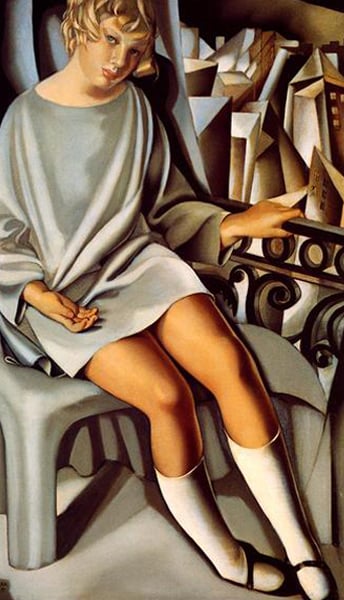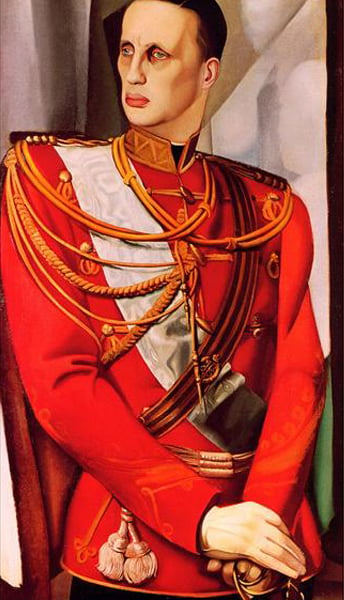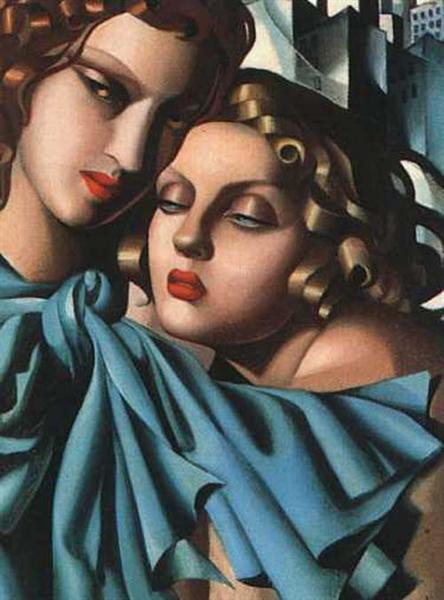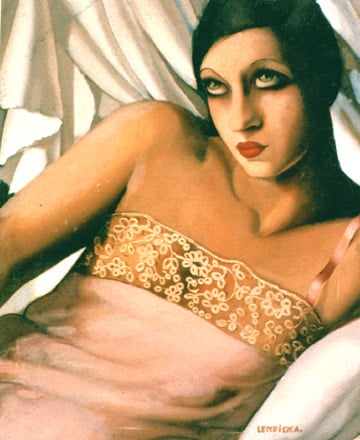The dark glamour of Tamara de Lempicka’s paintings
Her libido was legendary, but the rebellious biography of Polish artist Tamara de Lempicka is nothing when compared to the revolutionary canvases she painted. Born Tamara Gurwik-Górska to a wealthy family in 1898 Warsaw, 122 years ago today, De Lempicka reached the peak of her career in 1920s Paris, where she revelled in the glamour and lasciviousness of interwar elite society. De Lempicka became a key figure in the avant-garde movement, a fact sometimes overshadowed by her lifestyle and connections to famed cultural figures of the Left Bank: Pablo Picasso, André Gide, Colette. A hedonistic but ruthlessly self-starting woman, De Lempicka took to painting primarily to make a living, after her family jewels and husband’s fortune were lost in the post-revolution St Petersburg they’d escaped in 1919. “There are no miracles,” she said. “There is only what you make.”
Style and work
The style of De Lempicka’s paintings — sleek, erotic, and up-close — distinguish her work from that of her Art Deco contemporaries. So too did her focus and perspective. Where the likes of Diego Riviera and Josep Maria Sert often worked on large-scale murals that captured the crowds of an intermingling society, De Lempicka was fixed almost exclusively on portraits. Many of her subjects were plucked from the bourgeois bohemia that surrounded her, and many of them — men and women, models and patrons — shared her bed. De Lempicka was bisexual, had a rapacious sexual appetite, and was known for her many love affairs. Even in the louche circles of Paris’ avant-gardists, the intensity and scope of De Lempicka’s intimate life made her an unusual woman. The fact she painted personal and intimate subjects at all — a rarity among Art Deco artists — made her more unusual still.
With the onset of the Second World War, De Lempicka and her second husband moved to the United States, conflict upending her life for a second time. The Art Deco flair of her paintings lost their place in a world shaken again by war, and soon went out of fashion. Despite a brief resurgence some years later, her paintings faded behind the modernist and conceptual art that arrived in its place.
There is a seduction to De Lempicka’s paintings; most of them are advertisements of an aspirational future. But there is a dark glamour in them too. In retrospect, the works De Lempicka painted during her style-defining 1920s and 30s are a poignant, at times foreboding mirror of the era. Often backdropped by gleaming cityscapes, the paintings are a hymn to the rise of futurism and its attendant reverence for the machine and passion for war, the echo of which grew louder as Europe marched towards fascism.
Tamara de Lempicka, The Refugees (1937). ©Tamara de Lempicka / Wikiart
In 1937, just before the outbreak of the war, De Lempicka painted The Refugees. Three years later, newly settled in California, she painted The Escape. Both images are a response to the desperation wrought by the war in Europe, and an unusual application of a style usually reserved for glamour and excess.
Up close: De Lempicka’s most iconic painting
Tamara de Lempicka, Tamara in a Green Bugatti (1929). ©Tamara de Lempicka / Wikiart
One of De Lempicka’s most iconic works is this self-portrait, Tamara in a Green Bugatti , painted in 1929 and commissioned by German fashion magazine Die Dame for the cover of an issue celebrating women’s independence. In the painting, the female figure is seated, hands gloved, at the wheel of a Bugatti racing car. The pure colours and metallic sheen are a nod to futurism; the car itself is a symbol of women’s freedom. The half dropped eyelids radiate an icy seduction and the woman is given an almost pornographic look through the carmine hue of her lips. She is both wealthy and beautiful. She may stop the car to offer a ride, but it’s more likely that she’d mow you down. The subject — De Lempicka herself — exudes a power that suggests she is in control. But true to the embroidered image De Lempicka sometimes spun of herself, this too is not a fully accurate portrayal. She changed the driver’s seat from right to left. She also did not own a Bugatti, but considered her small yellow Renault to be too pedestrian to feature. The painting is an appealing fantasy and a manipulative act of self-aggrandisement.
Defining features
Crystalline, tubular, and voluptuous, De Lempicka’s portraits stylistically draw a line between the synthetic cubism of Pablo Picasso and French neoclassicism. The small geometric shapes that build the paintings collectively create a dramatic effect, but the classical portraiture at the heart of them — the focus on an individual, her expressions and mannerisms — also make them relatable. This is what gives De Lempicka’s paintings their unique power: they manage to be both highly stylised and also strangely realistic. To glance at one of her paintings is to see a continuation of texture, the smooth gloss of skin matching the smooth gloss of fabrics that envelop her subjects.
The style for which De Lempicka became known arrived by way of Renaissance art, which influenced her during teenage travels in Italy. First studying classical painting, De Lempicka reinvented her style and later entered the Paris studios of esteemed symbolist Maurice Denis and cubist André Lhote, who are credited with softening the angular, garish element of her painting. Her neo-classicism and modernisation of French portraiture is particularly rewarding in her painting Women Bathing.
Tamara de Lempicka, Women Bathing (1929). ©Tamara de Lempicka / Wikiart
Clearly inspired by the hareem of curvaceous nude women in Jean-Auguste-Dominique Ingres’s painting, The Turkish Bath, De Lempicka’s sapphic version is sensual and graphic. Each woman bears her own expression, achieved not through the literal, detailed renderings of classical painting, but supine curves sparingly used. Their bodies crowd the canvas, and even when perspective discerns the women as distant from each other, they all appear to be touching.
In De Lempicka’s paintings, the city is sometimes replaced by folds of fabric or grand staircases, but when it does appear, it is polychrome steel, a mise-en-scene that is idealised, never drab. Like many of the artistic luminaries of the interwar years, De Lempicka was a scenario builder, using her paintbrush principally to draw life not how it was, but how it could be.
This article is part of our series Women, Recollected, an ongoing project shining a light on the forgotten women pioneers of 20th century culture.






